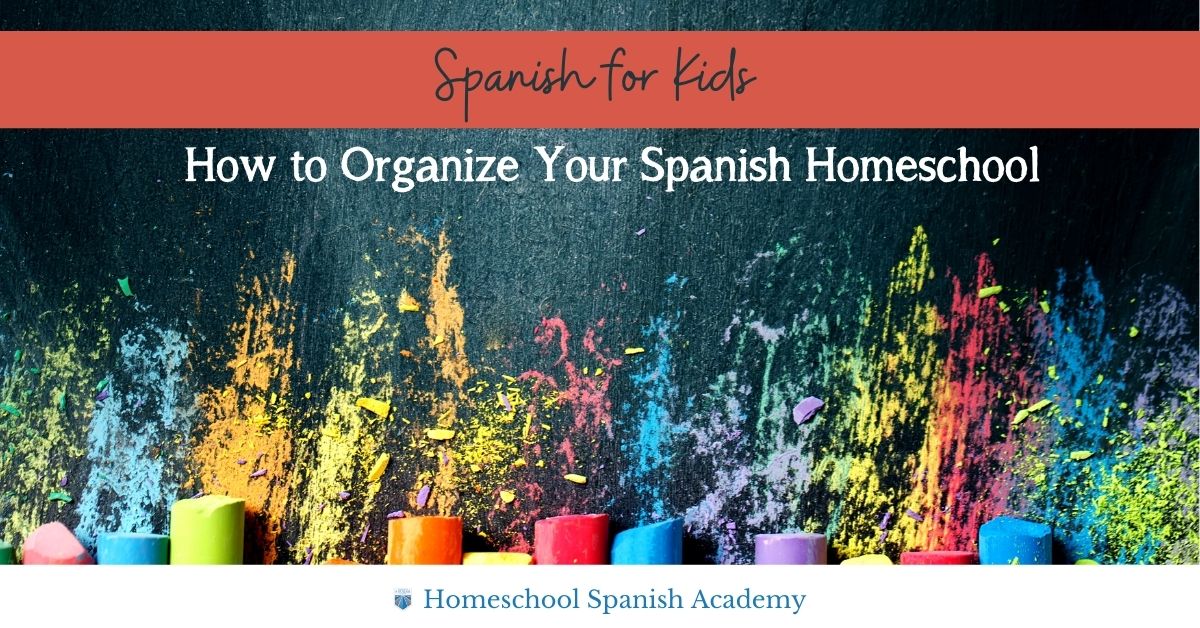
Spanish for Kids: How to Organize Your Spanish Homeschool
Do you teach Spanish for kids at your homeschool?
It’s a surefire way to give your children the valuable gift of learning another language. Plus, it comes along with tons of cognitive benefits and academic perks! What’s more, they’ll gain key life-enhancing skills like empathy, perseverance, and a love of learning.
Keep reading to
- find out more about your child’s most prominent learning style and how to best cater to it,
- discover super helpful tips for organizing your Spanish homeschool, and
- self-assess your teaching philosophy as a homeschooling parent.
Let’s delve into learning how to teach Spanish for kids most effectively!
What is Your Child’s Learning Style?
Your student’s (or students’) learning style is an important factor to consider when setting up your bilingual homeschool.
If you’re unsure of your child’s predominant learning style, check out the three descriptions below. Keep in mind that most kids do not fall into a single category exclusively. Instead, they tend to use all three learning styles but usually prefer one over the others.

1. Visual/Spatial Learners
Visual learners learn best by seeing. Reading information, associating concepts with pictures, taking handwritten notes, and watching demonstrations are all potent learning methods for a visual learner.
Visual learners also like diagrams, drawings, and charts—all visual concepts. They may be habitual doodlers, observant, focused, and organized.
To engage a visual learner in a Spanish for kids lesson, you’ll want to include elements like maps, photos, and other imagery. Try to find relevant visual aids to accompany the lesson content.
Encourage visual learners to sketch out their ideas, create mind maps and flowcharts, and highlight their notes in different colors. These strategies may come to them naturally; if not, a bit of prompting is helpful.
2. Auditory/Musical Learners
Auditory learners learn best by hearing. They like listening to lectures, audiobooks, and classes or programs that involve listening activities and music. They love listening to stories, poems, and books read aloud and can effectively retain the information that they hear.
Many auditory learners are particularly adept at distinguishing notes and tones in music and speech. They often like to talk, hum, and sing and may say words out loud to better learn them.
Try to work on your delivery so you can give a lesson or read aloud in engaging tones. Encourage your auditory learners to read their notes aloud to themselves. Also consider recording lessons for later listening and reference.
3. Kinesthetic/Physical Learners
Kinesthetic learners learn best by doing. An ideal approach for a kinesthetic child integrates bodily movement. Consider the value of providing extra hands-on activities for each subject to help reinforce concepts and keep your child engaged.
The use of props and models helps kinesthetic learners process information much better than from a book or whiteboard. These hands-on learners like to physically engage with the materials of the subject matter. They’re often energetic, action-oriented, and outgoing.
Channeling their energy and excitability is key to offering an effective Spanish for kids lesson. Take regular breaks so they can move around. Also, try to incorporate movement within the lesson itself. Encouraging movement during study is preferable to punishing them for fidgeting.
5 Tips for Organizing Your Spanish Homeschool
While keeping all this in mind about the different learning styles, remember that no one perfect way to set up your homeschool exists. Check out these five handy tips, and use whatever resonates with you!
1. Stay Consistent
Short daily practice sessions are a lot more effective for language learning than longer, less frequent lessons. The more practice, the better. Promote consistency by doing your Spanish for kids lessons at the same time each day, say as part of your morning routine or afternoon snack time.
However, be careful not to overextend or overschedule. “Spanish class” encompasses spelling, writing, grammar, literature, reading instruction, listening, and speaking. If you try to do all these subjects during every Spanish for kids class, you’ll likely burn out. Instead, alternate days or use blocks to fit in all your subjects. Everything needs to be done regularly but not necessarily daily.
And on special occasions, it is totally fine to let your kids watch Netflix in Spanish!
2. Use Scheduling Strategies
Create a routine, not a schedule. For most homeschooling families, trying to adhere to rigid time slots is an exercise in frustration.
Why create a strict schedule with a Spanish grammar lesson at 8:00, reading at 8:45, and spelling at 9:15? Instead, aim to begin your first block sometime between 8:00 and 8:30, and plan to have one activity follow the next.
Remember to take frequent, short breaks (the younger the child, the more frequent the breaks need to be).
Consider scheduling supplemental practice sessions, too. Let them watch videos in Spanish, listen to Spanish audiobooks, or play on a language app. Motivation is key for learning, so try to match the extra practice to your child’s interests as much as possible.
3. Follow Your Family’s Flow
Homeschooling allows us to follow our natural rhythms rather than the set schedules of traditional school. If your children are not early-morning risers, avoid scheduling an early start to your day. Take advantage of the flexibility homeschooling offers, and work at your times of peak productivity.
Also, consider your children’s natural rhythms and the fact that they have variations. For example, if you have one child who hits the ground running at 7:00 a.m., schedule their independent work first.
4. Deliver Age-Appropriate Lessons
Young children have a few advantages in language learning. Starting early can help improve their cognitive function. (See also: The Brilliant Way to Homeschool Your Preschool (Pre-K) Child.)
For elementary kids, it’s ideal to teach through immersion. This involves providing exposure to the language, playing games, and speaking in the target language.
In contrast, middle and high schoolers benefit from direct grammar instruction. They can draw parallels between their native English and the Spanish they’re learning.
5. Prioritize Speaking Practice
Seek out opportunities for your kids to interact with native speakers. Options include online Spanish classes or interacting with Spanish speakers in the community.
Go to Spanish-language storytimes at the public library. Arrange Spanish-language play dates or conversation groups.
Also, consider volunteering with a community organization that serves Spanish speakers. This will give your children the chance to practice their Spanish while helping others.
Hand-picked for you! Homeschool in Spanish: How to Teach Your Child Spanish at Home
What is Your Teaching Philosophy?
Your teaching philosophy is another key factor that will guide your Spanish for kids homeschooling journey.
Consider the following questions:
- How much will your children learn independently? How much will they need your guidance?
- What role should literature play in instruction? Are textbooks necessary?
- How much time and energy do you have to put into hands-on projects?
- How are you most comfortable teaching Spanish for kids?
- Are you comfortable making up your own curriculum by drawing from a variety of sources?
When you are selecting a curriculum, think about the curriculum in terms of how well it fits your answers. If you are not comfortable creating a curriculum by pulling from a variety of sources, you may want to consider your other options. Like paying for a curriculum or, better yet, outsourcing your Spanish for kids classes to an online academy. Which brings me to my next point…
Spanish for Kids: Outsourcing is a Valid Approach
For over 10 years, Homeschool Spanish Academy has offered fun, immersive Spanish classes for remote learners. Our unique curriculum and teaching style is tailored to the needs of students of all ages and levels. Learn more about what to expect and book a free trial class for your kids. It’s an extraordinary way to include Spanish in your homeschool routine, especially if you don’t speak the language yourself.
Want some free Spanish lessons for your foreign language homeschool? Check these out!
- Revamp Your Homeschool Spanish Journey with AI Magic
- How You Can Encourage Your Child To Speak Spanish at Home
- Keep Your Spanish Skills Sharp Over Summer Vacation
- Discover the Joy of Learning Spanish with Summer Fun Activities
- What Is An Umbrella School?
- The Best Homeschool Spanish Curriculum at HSA
- From Burnout to Balance: Creating a Healthy Happy Homeschool Routine
- 10 Homeschooling Styles You Need to Explore in 2023
- Ver Conjugation: Free Spanish Lesson, Exercises, and PDF - December 5, 2024
- What Are the Different Levels of Language Proficiency? - October 17, 2024
- Master All the Forms of Ser in Spanish: Your Ultimate Grammar Guide - July 18, 2024





